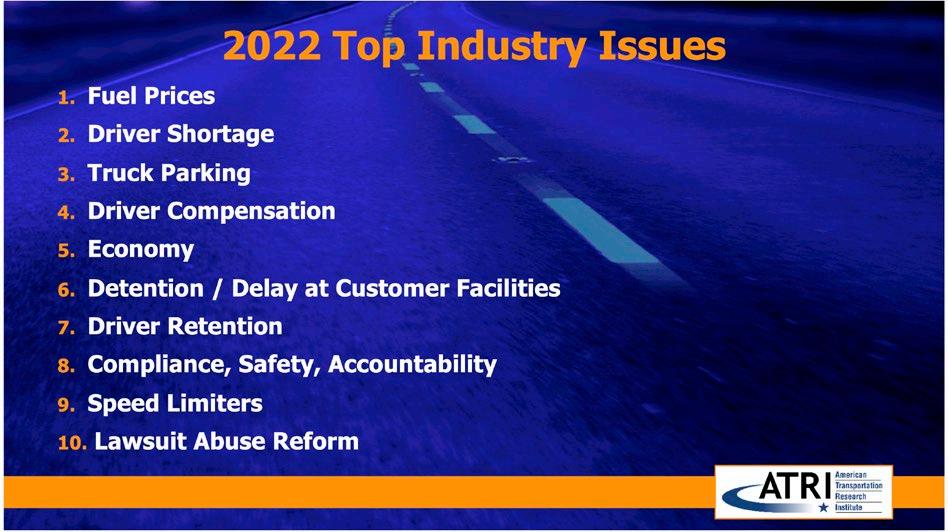
3 minute read
AMID TRIPLE SQUEEZE
The food supply chain recently has endured a powerful “triple squeeze” that has brought an array of profound challenges. Persistently high inflation, scarce and expensive talent, and global supply issues have compounded pressures for the food supply chain industry and made decisionmaking for executives a minefield of challenges.
In a collaborative webinar with the Food Shippers of America (FSA) in October, experts from FTR shared their insights on the state of food shipping and the broader economy while looking ahead to 2023 and what conditions the new year will bring. In general, Jonathan Starks, Chief Intelligence Officer for FTR, is concerned that overall economic risks are “weighted to the downside” in the initial months of 2023.
“That doesn’t necessarily mean that we’re looking for a significant negative sustained environment going forward, but it does mean that the risks of the market going negative for a period of time are out there and they’re fairly substantial and worth keeping a close eye on for the next six to nine months,” Starks says.

Starks highlights how various foodrelated markets have fared since the pandemic and how they look entering the new year, including beverages (“really strong growth coming out of the early pandemic that really has petered out recently but it’s still at a high level”), grain mill products (little impact from the pandemic), meat and poultry (hindered early in the pandemic but bounced back to normal) and dairy products (upward movement early in the pandemic and still strong).
“From an overall food products perspective, things in general are still running at a pretty high level,” says Starks. “That means demand is still there.”
Avery Vise, Vice President of Trucking at FTR, says the wellpublicized supply chain disruptions that led to steep inventory shortages in 2021 have faded from view in the food sector and 2022 saw a return to “an essentially normal range of inventories.”


In addition, Vise suggests the unusually high spot trucking rates and volumes that saw a sharp surge in 2021 have normalized, and “we’ve come back down to the five-year average.” That does not mean the freight market is weak, he emphasizes. In fact, he says that tonnage by trucks is strong and “on the truck side, we’re seeing really strong volume growth for food products.”
• pallet fit™ door fits any pallet height
• reduces labor
• works with full, partial, or single layer pallets
• no more need for plug pallets, zone can run with one or multiple empty pallet positions








• increased airflow
• more flexible
• more efficient

• more $aving$

However, rail is “a different story,” Starks observes. “The numbers have been more volatile, and overall, they’re weaker on the rail side.”
Todd Tranausky, Vice President of Rail and Intermodal at FTR, says rail has struggled with service levels in recent years, and FTR expects those problems to remain at least through the first quarter of 2023.

According to Tranausky, food shippers often ask why service levels in rail have faced an extended period of struggle: “It comes down to people – and having enough of them to keep up with volumes.” Labor tightness is not unique to rail, but he notes that they’ve certainly had their own unique challenges in terms of hiring people and had a wave of layoffs and furloughs even before the pandemic brought additional labor strain.
A key source of relief for the food supply chain in 2023 could come from diesel prices. According to Dean Croke, Principal Analyst for DAT Freight and Analytics, the U.S. Energy Information Association has a forecast average diesel price of $4.23 per gallon in 2023 versus $5.31 in 2022.
Vise says a development to watch going into 2023 is signs of a shift in where consumers buy food. For instance, he highlights an increase in food purchased at hotels and restaurants (3.8%) and a decline in food purchased at food and beverage stores (2.4%) during 2022’s second quarter. He points to two factors in the trend: One was a fulfillment of the expectation that Americans would travel more and eat out more once the pandemic appeared to be largely behind them. The second factor is that inflation for “food at home” prices has been higher by a substantial margin than for “food away from home” prices.
“I think the effect has been to essentially narrow the gap between eating out and eating at home from a cost standpoint and in fact probably making it cheaper to eat in a lower-cost outlet – in other words, fast food,” says Vise. “So the fast food outlets probably are getting more business because it is as cheap or cheaper in many cases to eat that food than it is to go to the store, buy food and cook, which is obviously a fairly big change.”
FSA and FTR have partnered together to bring FSA members a unique combination of economic and logistics industry information. Visit FoodShippers.org, go to “News & Trends” and click “Industry Forecasts.”











